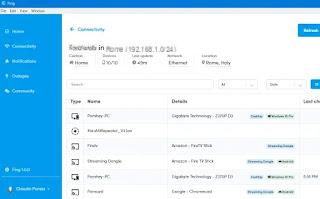 With the spread of Smart devices, all connected to the network and in many cases also to the internet, it can be useful and interesting to have a general overview so that you can see how many of them are connected, what they are and if there are intruders or problems. Today, there are many devices that connect to home Wi-Fi: PCs, smartphones, tablets, smart TVs, voice assistants, game consoles, Wi-Fi printers and more.
With the spread of Smart devices, all connected to the network and in many cases also to the internet, it can be useful and interesting to have a general overview so that you can see how many of them are connected, what they are and if there are intruders or problems. Today, there are many devices that connect to home Wi-Fi: PCs, smartphones, tablets, smart TVs, voice assistants, game consoles, Wi-Fi printers and more.The best way to see the list of wifi connected devices, although not the simplest, to find this information is to check the web interface of the router that hosts the network and spreads the Wi-Fi signal. Most routers allow you to view the list of connected devices, although some may not be easy to read or may not be at all.
Still worth it check the router interface, also to understand what we are talking about.
As seen in another guide, it is easy to access the router interface. Basically this is simply writing the IP address of the router in the address bar of Chrome or other web browsers and pressing Enter to open the router configuration as if it were a website. If you are unsure of the router's IP address, you can search from the network settings or by opening a command prompt (by searching for CMD on the Start menu or by right-clicking on the Windows Start button) and using the ipconfig command. The IP of the router appears with a number like 192.168.1.254, near the writing Default gateway.
Opening the router's web interface, enter the name and password indicated in the instruction booklet which should usually be Administrator and without password (see also default names and passwords on routers). Then it will be necessary look for the connected devices screen in the router's web interface.
On many D-Link routers, the list of connected devices is available in the Status> Wireless menu.
On many Netgear routers, the list is under "Connected Devices" or Connected Devices in the sidebar.
On many Linksys routers, this option is available under Status> Local Network> DHCP Client Table.
Many routers simply provide a list of devices connected via DHCP, so if a device is configured with a static IP, it won't show up in the list. For each device the assigned IP, the Mac address and the host name are indicated.
Programs to control network connected devices
The easiest way to check networked devices and having a list of computers, smartphones and other smart home appliances is to use a scanning program.There are many tools to scan the network and in this article we see the most powerful and the most simplified.
1) Wireless Network Watcher by NirSoft is a free little tool that doesn't even need to be installed on your computer. To use it, you just have to start it and the automatic scan will show the names of the devices connected to the network, the MAC addresses and the hardware manufacturer, very useful for identifying devices and computers even if they have an unrecognizable name. This tool may not work properly if you do not specify the Wi-Fi network card in the Advanced Options.
2) Fing is the most powerful tool to be used to discover all the devices connected to the network. Fing is free to use on PC (even on Android and iPhone smartphones), although to use it you need to create a free account on the Fing website.
Fing is really beautiful to look at; in the Connectivity tab is possible list all devices connected on the network (both wifi and cable), show name, IP, MAC Address, manufacturer and operating system. Fing is also useful for checking if the internet connection is working well or if there are widespread disruptions.
Within Fing, it is possible to assign names to these devices (do not change the host names), for example to give a recognizable name or to indicate who the device belongs to. This allows you to easily see when an unauthorized device is on the network (for example if someone is using our wifi).
Other free programs can be downloaded from the article on how find out who is connected to your wifi network and connects wirelessly.
If you want to use a smartphone, there are some too applications for Android to scan the network
See all the devices connected on the network to the wifi


























